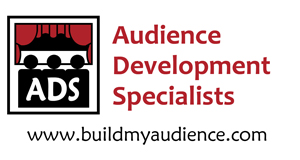TGIF! I hope you all have some enjoyable weekend arts events planned. Today has been a whirlwind of activity for me, so I thought I would update you.
- I started off the day with a mini-podcast after seeing this article:
Ticketmaster report: theatre audiences getting younger and more experimental
[soundcloud url=”http://api.soundcloud.com/tracks/113822295″ params=”” width=” 100%” height=”166″ iframe=”true” /]
After recording, Howard Sherman tweeted at me that the report has 1,000 UK respondents, 200 US, 100 Ireland, 100 Australia, 50 Germany. This is an odd sample, but good to know more worldly. He also shared with me a link for his commentary stating that this Ticketmaster report “wrongly reduces the impact” of NEA and Americans for the Arts reports:
www.hesherman.com/2013/09/27/arts-…-builds-mr-data/
- Next, I completed my slides for an upcoming workshop for Boulder County Arts Alliance –
Audience Affairs, Session 2 – Build Relationships to Build Your Funding
- The end of the day was a meeting with my National Arts Marketing Project Conference group. We are doing a session at the conference:
CONQUERING THE FEAR FACTOR: CREATING AND PROMOTING GREAT A/V CONTENT ON A SHOESTRIN
The conference is in Portland this year from November 8-11. Our presentation is on Sunday the 10th. Sign up here!
- My thoughts today were about apathy in the arts, my new website, reports and their accuracy (or bias), how I can make a difference, and whether or not I should release my $5 webinars for free since they are good sources of information, but no one has expressed interest yet.
- For today’s Giving Program gift, do visit Howard Sherman’s blog, especially if you are a theatre person. I have always found his entries to be insightful and intriguing about current events. He has a viewpoint that is grounded yet reaching for the new, a very enlightening perspective.
Please feel free to share your mess of thoughts today, and have a super weekend!
Cheers to happy and loyal audiences,
Shoshana
Shoshana Fanizza
Audience Development Specialists
https://www.buildmyaudience.com
“Never treat your audience as customers, always as partners.”
~James Stewart
Please consider supporting ADS so we can continue our work. Donate here!






The Ticketmaster is spurious, there is a lack of relevant representativeness in the small sample sizes and its dangerous to treat it as gospel. There is so much more substantive research released in the UK for many years by organisations like ACE, DCMS, SOLT and so on.
Thank you, Tim. Feel free to post the links to some of these reports if you have them handy. As I mentioned to another person with a similar view, this report is not the end all and be all, but there are a few points that make it worth talking about – the need for new content (which has been reported before) and the fact that word of mouth is the number one way people hear about an event (also in other reports). Thank you for commenting, and we will be careful to take these reports with a grain of salt especially in view of where they originate.
Methodology for this report:
All the research we’re referring to, unless explicitly referenced otherwise, comes from primary research conducted online by Ticketmaster UK. We used Ticketmaster’s Live Analytics ticketing data and the SOLT Theatres report as a guide for our sampling and to get a sense of where theatre attendees in the UK are coming from.
We then partnered with sampling agency Research Now to recreate a representative sample of theatre attendees in the UK , with attendance to at
least one theatre event in the past 3 years as our screener. We focused
primarily on UK attendees, but complemented this with attendees from broad:
1006 theatre attendees from the UK (representative sample)
200 attendees from the US (indicative sample)
100 from Australia (indicative sample)
100 from Ireland (indicative sample)
50 from Germany (indicative sample)
Respondents who were screened out (362) were treated as non-attendees and were routed to questions around barriers to entry. Response numbers above exclude flatliners, rogue respondents and partial completes.
For the purposes of this research, we defined ‘theatre’ as plays, musical, opera,dance and other performances excluding comedy and music.
The fieldwork was conducted between 3 May 2013 and 23 May 2013
Please note that as the research was conducted online, some of the comparisons between online and offline behaviour may have a skew toward online.
Where relevant and referenced within the analysis itself we have complemented and contextualised our research with external sources.
***************************
Yes, the sample was extremely strange, and it was a small sample. I will say, seeing that it was a small sample, it was still eye opening that a younger audience registered so highly. Wouldn’t a small sample, randomly picked, show a smaller percentage for these younger age groups? This is what we see in the United States for the most part. So, either the sample was chosen in bias, or if on the up-and-up, it is indicating something different than some of the other reports. Perhaps if Ticketmaster went back and crunched numbers for a bigger sample that people would find more valid, we could see if this data holds up.
I still stand by two points this report does make – younger generations want new content and word of mouth is king.
Yes I saw the references in the report to methodology. Hence, I stand by my reservations.
It used a very broad definition of theatre “plays, musical, opera,dance and other performances excluding comedy and music”
It appears that the sample frame was its ticketing data, which could be questioned for its representativeness. It is just purchasers of tickets for events that they hold contact details for, not all attendees and for a portion of purchasers of tickets for events at that.
It is not a random sample, attempts may have been made to make it a stratified sample but that is still a very small sample that makes me question the robustness, representativeness and hence any results or breathless suppositions.
Tim, do you have a few links to other reports I could look at? My search thus far has not gone well. Perhaps in their referencing other reports, what I have been mentioning holds true, but you are right that in their sampling, their statistics for representing age of theatre goers may not be valid enough. They would only have access to the events in their database and not the entire theatre sector, as you mention.
So with this discussed, I agree we cannot conclude that their enthusiastic numbers for a younger audience holds water for the sector. However, I have seen in other reports that have more due diligence, younger generations prefer new content and word of mouth is most effective.
By the way, I posted the methodology for others to see, since I knew you already have seen it. Thanks again for letting us know your feedback on this report.
Here you go as a start Shoshana
This one has also just been released, but closer to home for you and a whole lot more representative.
How a Nation Engages with Art: Highlights from the 2012 Survey of Public Participation in the Arts
National Endowment for the Arts (NEA), September 2013, USA
http://arts.gov/sites/default/files/highlights-from-2012-SPPA.pdf
Another recent substantive example.
Experience of the arts by adults in Northern Ireland 2012/13
Findings from the 2012/13 Continuous Household Survey. This bulletin presents analysis on the following topics:
Participation in arts activities
Attendance at arts events
Engagement with the arts
Trends in engagement with the arts from 2007/08 – 2012/13
Frequency of engagement with the arts
Previous experience of the arts
Satisfaction with arts provision in Northern Ireland
Published 19/09/2013
http://www.dcalni.gov.uk/arts_chs_2012-13_bulletin.pdf
Another country and a heap of research available from Creative New Zealand:
http://www.creativenz.govt.nz/en/arts-development-and-resources/research-and-arts-sector-resources
Audience Atlas New Zealand report 2011
This is a detailed survey of cultural audiences in New Zealand. The survey covers 39 artforms and leisure activities and 640 individual arts, culture and heritage venues throughout the country. It measures lapsed, current and potential markets to provide detailed insight into New Zealand audiences.
Culture Segments New Zealand
Culture Segments is a new, international, sector-specific segmentation system for arts, culture and heritage organisations designed by Morris Hargreaves McIntyre (MHM). The system uses data from Audience Atlas New Zealand 2011, and draws on MHM’s experience to help organisations to understand and meet the needs of audiences for arts, culture and heritage.
New Zealanders and the arts full report 2011
This document is the full report of findings from independent research in 2011 into New Zealanders’ attitudes to, attendance at and participation in the arts.
The UK’s turn. 1st from Arts Council England
http://www.artscouncil.org.uk/what-we-do/research-and-data/arts-audiences/
Arts audiences
There are two main resources that we use to improve our understanding of how and why people engage with the arts:
Taking Part survey – a major national survey of cultural participation that has been running since 2005
Arts-based segmentation research – an in-depth analysis of the patterns of consumer behaviour and arts engagement in England based on data from the Taking Part and TGI surveys
We are also a partner in ‘Understanding Everyday Participation – Articulating Cultural Values’, a large-scale project to research how people participate in culture, sport and other social and civic activities in their everyday lives. The research aims to develop new ways of understanding and measuring participation and its value based on how people live their lives today and what is important to them. The project is a collaboration between four universities and 12 national partners and is funded by the Arts and Humanities Research Council until 2017.
You can also read about the Active People and TGI surveys that have historically been used to understand arts engagement in England. For further historical context to our audience research, see the final report from the New Audiences Programme (2004).
We are currently supporting the arts sector to better understand audiences by commissioning work through the Audience Focus fund.
Next, Audiences London
http://www.audienceslondon.org/2208/resources-overview/free-resources.html
http://www.audienceslondon.org/2616/snapshot-london/snapshot-london.html
And Department for Culture, Media & Sport
https://www.gov.uk/government/publications?keywords=&publication_filter_option=research-and-analysis&topics%5B%5D=arts-and-culture&departments%5B%5D=all&world_locations%5B%5D=all&direction=after&date=2012-01-01
Particularly, the CASE programme: understanding the drivers, impacts and value of engagement in culture and sport
https://www.gov.uk/government/publications/case-programme-understanding-the-drivers-impacts-and-value-of-engagement-in-culture-and-sport
Thank you, Tim. Hopefully over the weekend I can look at these surveys so I can do a follow up post. Have a great rest of your week!
One more Shoshana, Taking Part is a much more substantive view of participation in the UK than the Ticketmaster effort. A fresh set of data is available now and it has run since 2005.
https://www.gov.uk/government/publications/taking-part-201314-quarter-1-statistical-release